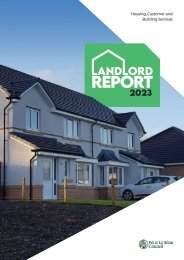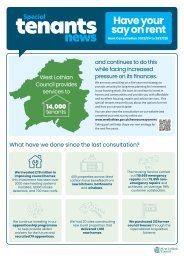West Lothian Council Newsletter - Spring 2023
Bulletin is West Lothian Councils public newsletter.
Bulletin is West Lothian Councils public newsletter.
Create successful ePaper yourself
Turn your PDF publications into a flip-book with our unique Google optimized e-Paper software.
WESTLOTHIANCOUNCIL @LOVEWESTLOTHIAN WESTLOTHIANVIDEOS WWW.WESTLOTHIAN.GOV.UK<br />
Bulletin<br />
5<br />
Spotlight on:<br />
Road repairs<br />
On average <strong>West</strong> <strong>Lothian</strong> <strong>Council</strong> carries out<br />
210 pothole repairs each month.<br />
Why do potholes occur?<br />
Very cold weather does result in more<br />
potholes. The RAC recently said that the<br />
weather in January <strong>2023</strong> was the perfect<br />
recipe for potholes on roads – which is<br />
as a result of heavy rain and freezing<br />
temperatures.<br />
Jim Jack, the council’s Head of Operational<br />
Services said:<br />
“Water will find its way into any cracks in the<br />
road surface. If this freezes, the ice formed<br />
will put pressure on the road surface, forcing<br />
the cracks open. When the ice thaws the<br />
gap left is a weak spot, which can become<br />
a pothole as traffic runs over the area.<br />
This winter we experienced a cold snap<br />
before Christmas, followed by very wet<br />
weather and another cold period. These<br />
combined are the worst conditions we could<br />
experience in terms of the road condition.”<br />
“To put this into context, our team has<br />
repaired around 700 potholes in January<br />
<strong>2023</strong> alone, compared to our normal<br />
workload of around 210 per month.<br />
“Despite the extremely challenging<br />
financial position that the council faces,<br />
our road network overall is in good<br />
condition in <strong>West</strong> <strong>Lothian</strong>, and we continue<br />
to work to maintain that.”<br />
How are they fixed?<br />
“Our primary concern with potholes is<br />
to ensure that the road network is safe<br />
and every defect is inspected and a risk<br />
assessment is carried out to determine the<br />
response time required for a repair. For<br />
high risk defects this means that we will<br />
infill potholes within 24 hours of the defect<br />
being recorded and we will return at a later<br />
date to undertake permanent repairs if<br />
required.<br />
“More often than not, our team will put<br />
in place a temporary patch. This ensures<br />
that the roads are safe in the short term<br />
and reduces the<br />
damage done<br />
to vehicles. Our<br />
team will return soon<br />
afterwards to undertake<br />
a full and permanent<br />
repair if that is required. This<br />
can involve traffic management<br />
or even temporary closures so a<br />
patch is helpful to both ourselves and<br />
motorists as it prevents having to close<br />
roads completely whilst we schedule in<br />
permanent repairs.<br />
“Our safety inspection programme is<br />
ongoing and we also respond to all reports<br />
of road defects.<br />
“We have dedicated teams working to<br />
infill potholes at all times. Generally<br />
speaking potholes assessed as lower risk<br />
can be infilled within five working days<br />
although some may take longer due to the<br />
circumstances of the repair.”<br />
What can<br />
customers do to help?<br />
We would encourage people to use the<br />
web form on the council’s website to<br />
report any potholes or other road defects.<br />
Potholes and road defects can be reported<br />
by scanning the QR code or visiting<br />
www.westlothian.gov.uk/report<br />
CUT<br />
OUT<br />
OUT CONTAMINATION<br />
Contaminated material can’t be separated or cleaned, meaning whole bin-lorry<br />
loads can end up being disposed of rather than recycled. This is very harmful to<br />
the environment and is expensive to dispose of contaminated material.<br />
Contaminated material should be placed in your grey bin.<br />
Residents are responsible for removing any contaminated material from their bin.<br />
The council will not empty contaminated bins. Bins will only be emptied when<br />
the contamination has been removed.<br />
The council is appealing to residents for their support in tackling the problem.<br />
We can provide households with advice on what items should be placed within<br />
each bin to avoid issues with contamination.<br />
What goes into your bin?<br />
Make sure everything put in green<br />
and blue bins is clean and dry.<br />
Clean and dry:<br />
Plastic bottles<br />
Tubs and trays<br />
Tins, cans, aerosols<br />
For reminders of what waste<br />
should go into each bin and<br />
to request an additional bin,<br />
please scan the QR code or visit:<br />
www.westlothian.gov.uk/bins<br />
Green bin<br />
Foil and metal lids<br />
Cartons<br />
Empty plastic<br />
bags<br />
Blue bin<br />
Plastic bottles, tubs and trays, tins, cans,<br />
aerosols, foil and metal lids, food and<br />
drink cartons and empty plastic bags.<br />
Clean and dry: Paper, card and<br />
cardboard only.<br />
No other materials should be placed into<br />
blue bins. No plastic bags please.

















